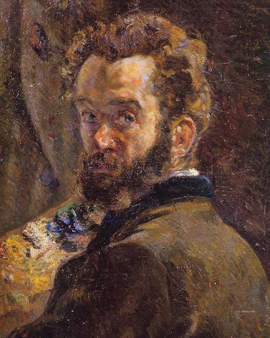Jean-Baptiste Armand Guillaumin was a French Impressionist painter and litographer. He grew up in rather modest circumstances as the son of a worker. Guillaumin lacked the necessary financial means for a classical art education. At the age of fifteen he worked in his uncle's lingerie shop and later for the French railways. So he could dedicate himself to his true passion, art, only in his free time and continued to educate himself autodidactically. He was finally able to afford to attend the Académie Suisse in 1861. There he made the acquaintance of Paul Cézanne and Camille Jacob Pissarro, with whom he had a deep friendship throughout his life. Although Guillaumin never attained the same fame and recognition as Cézanne or Pissaro, he is said to have had a strong influence on their works. For his first graphic work, for example, Cézanne used a painting by Guillaumin. Together with Cézanne and Pissaro, Guillaumin was also a regular exhibitor at the Salon de la Refusé. He also exhibited several times at the Salon des Indépendants.
Guillaumin was deeply rooted in the impressionist scene. In his early works he was strongly oriented towards Édouard Manet. His later works, however, were very colorful and resembled the style of Claude Monet. Despite his great talent, however, the financial aspect always played a decisive role in Guillaumin's life and hindered his artistic activity considerably at the beginning. He had to continue his work at the road construction office for many years and, unlike his friends, could not afford to devote himself entirely to art. The acquaintance with Vincent van Gogh was a first step for Guillaumin towards financial independence. Van Gogh was impressed by Guillaumin's special feeling for nature and influenced him in his work. He introduced Guillaumin to his brother Theo van Gogh, who was an art dealer. He was able to sell some of Guillaumin's works for a profit. Only from 1891 onwards, however, Guillaumin was able to devote himself completely to painting and no longer had to worry about money. For he surprisingly won 100.000 Francs in the national lottery. Thereupon, he immediately gave up his job at the road construction office.
The money he won finally allowed him to settle in Crozant, a place that was very popular with many painters of his time. There he also became the director of the École de Crozant. In more than a hundred of his works he showed impressions of the surrounding Creuse region. He also undertook several trips to Provence, the Auvergne and the Netherlands, where he produced several landscape paintings. Besides landscape paintings, Guillaumin was also interested in still lifes, portraits and pastel paintings. While his early works can be attributed to Impressionism, his later works were more influenced by Fauvism. Guillaumin was married to his cousin Marie-Joséphine Charreton. He survived all other artists from the Impressionist movement and died at the age of 86.
×





.jpg)
.jpg)
.jpg)
.jpg)
.jpg)
.jpg)
.jpg)
.jpg)
.jpg)
.jpg)
_-_(MeisterDrucke-1659567).jpg)
_-_(MeisterDrucke-1659567).jpg)
.jpg)
.jpg)
.jpg)
.jpg)
.jpg)
.jpg)
.jpg)
.jpg)
.jpg)
.jpg)
.jpg)
.jpg)
.jpg)
.jpg)
.jpg)
.jpg)
.jpg)
.jpg)
.jpg)
.jpg)
.jpg)
.jpg)
.jpg)
.jpg)
.jpg)
.jpg)
_-_(MeisterDrucke-1659710).jpg)
_-_(MeisterDrucke-1659710).jpg)
_-_(MeisterDrucke-1659711).jpg)
_-_(MeisterDrucke-1659711).jpg)
_-_(MeisterDrucke-1660991).jpg)
_-_(MeisterDrucke-1660991).jpg)
.jpg)
.jpg)
_-_(MeisterDrucke-1172581).jpg)
_-_(MeisterDrucke-1172581).jpg)
.jpg)
.jpg)
.jpg)
.jpg)
.jpg)
.jpg)
.jpg)
.jpg)
.jpg)
.jpg)
.jpg)
.jpg)
.jpg)
.jpg)
.jpg)
.jpg)
.jpg)
.jpg)
.jpg)
.jpg)
.jpg)
.jpg)
_-_(MeisterDrucke-1659493).jpg)
_-_(MeisterDrucke-1659493).jpg)
.jpg)
.jpg)
.jpg)
.jpg)
.jpg)
.jpg)
.jpg)
.jpg)
.jpg)
.jpg)
.jpg)
.jpg)
.jpg)
.jpg)
.jpg)
.jpg)
.jpg)
.jpg)
.jpg)
.jpg)
.jpg)
.jpg)
_-_(MeisterDrucke-1128364).jpg)
_-_(MeisterDrucke-1128364).jpg)
.jpg)
.jpg)
.jpg)
.jpg)
.jpg)
.jpg)
.jpg)
.jpg)
.jpg)
.jpg)
.jpg)
.jpg)
.jpg)
.jpg)
.jpg)
.jpg)
.jpg)
.jpg)
.jpg)
.jpg)
.jpg)
.jpg)
.jpg)
.jpg)
.jpg)
.jpg)
.jpg)
.jpg)
_-_(MeisterDrucke-1455881).jpg)
_-_(MeisterDrucke-1455881).jpg)
.jpg)
.jpg)
.jpg)
.jpg)
.jpg)
.jpg)
.jpg)
.jpg)
.jpg)
.jpg)
.jpg)
.jpg)
.jpg)
.jpg)
_-_(MeisterDrucke-1440331).jpg)
_-_(MeisterDrucke-1440331).jpg)
.jpg)
.jpg)
.jpg)
.jpg)
.jpg)
.jpg)
_-_(MeisterDrucke-1505191).jpg)
_-_(MeisterDrucke-1505191).jpg)
_Mu_-_(MeisterDrucke-1419219).jpg)
_Mu_-_(MeisterDrucke-1419219).jpg)
 - (MeisterDrucke-192087).jpg)
 - (MeisterDrucke-192087).jpg)
_-_(MeisterDrucke-62831).jpg)
_-_(MeisterDrucke-62831).jpg)
.jpg)
.jpg)
.jpg)
.jpg)
_-_(MeisterDrucke-1130405).jpg)
_-_(MeisterDrucke-1130405).jpg)
.jpg)
.jpg)
.jpg)
.jpg)
.jpg)
.jpg)
.jpg)
.jpg)
.jpg)
.jpg)
.jpg)
.jpg)
.jpg)
.jpg)
_19th_-_(MeisterDrucke-946272).jpg)
_19th_-_(MeisterDrucke-946272).jpg)
.jpg)
.jpg)
_-_(MeisterDrucke-1470953).jpg)
_-_(MeisterDrucke-1470953).jpg)
.jpg)
.jpg)
.jpg)
.jpg)
.jpg)
.jpg)
.jpg)
.jpg)
.jpg)
.jpg)
.jpg)
.jpg)
.jpg)
.jpg)
.jpg)
.jpg)
_-_(MeisterDrucke-1118210).jpg)
_-_(MeisterDrucke-1118210).jpg)






